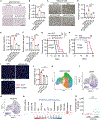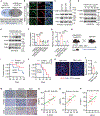Circadian regulator CLOCK promotes tumor angiogenesis in glioblastoma
- PMID: 36795563
- PMCID: PMC10423747
- DOI: 10.1016/j.celrep.2023.112127
Circadian regulator CLOCK promotes tumor angiogenesis in glioblastoma
Abstract
Glioblastoma (GBM) is one of the most aggressive tumors in the adult central nervous system. We previously revealed that circadian regulation of glioma stem cells (GSCs) affects GBM hallmarks of immunosuppression and GSC maintenance in a paracrine and autocrine manner. Here, we expand the mechanism involved in angiogenesis, another critical GBM hallmark, as a potential basis underlying CLOCK's pro-tumor effect in GBM. Mechanistically, CLOCK-directed olfactomedin like 3 (OLFML3) expression results in hypoxia-inducible factor 1-alpha (HIF1α)-mediated transcriptional upregulation of periostin (POSTN). As a result, secreted POSTN promotes tumor angiogenesis via activation of the TANK-binding kinase 1 (TBK1) signaling in endothelial cells. In GBM mouse and patient-derived xenograft models, blockade of the CLOCK-directed POSTN-TBK1 axis inhibits tumor progression and angiogenesis. Thus, the CLOCK-POSTN-TBK1 circuit coordinates a key tumor-endothelial cell interaction and represents an actionable therapeutic target for GBM.
Keywords: BMAL1; CLOCK; CP: Cancer; TBK1; and POSTN; angiogenesis; circadian rhythm; glioblastoma; tumor microenvironment.
Copyright © 2023 The Author(s). Published by Elsevier Inc. All rights reserved.
Conflict of interest statement
Declaration of interests The authors declare no competing interests.
Figures





References
-
- Chen P, Hsu WH, Chang A, Tan Z, Lan Z, Zhou A, Spring DJ, Lang FF, Wang YA, and DePinho RA (2020). Circadian regulator CLOCK recruits immune-suppressive microglia into the GBM tumor microenvironment. Cancer Discov. 10, 371–381. 10.1158/2159-8290.CD-19-0400. - DOI - PMC - PubMed
-
- Wen PY, Weller M, Lee EQ, Alexander BM, Barnholtz-Sloan JS, Barthel FP, Batchelor TT, Bindra RS, Chang SM, Chiocca EA, et al. (2020). Glioblastoma in adults: a Society for Neuro-Oncology (SNO) and European Society of Neuro-Oncology (EANO) consensus review on current management and future directions. Neuro Oncol. 22, 1073–1113. 10.1093/neuonc/noaa106. - DOI - PMC - PubMed
-
- Stupp R, Taillibert S, Kanner A, Read W, Steinberg D, Lhermitte B, Toms S, Idbaih A, Ahluwalia MS, Fink K, et al. (2017). Effect of tumor-treating fields plus maintenance temozolomide vs maintenance temozolomide alone on survival in patients with glioblastoma: a randomized clinical trial. JAMA 318, 2306–2316. 10.1001/jama.2017.18718. - DOI - PMC - PubMed
Publication types
MeSH terms
Substances
Grants and funding
LinkOut - more resources
Full Text Sources
Medical
Molecular Biology Databases
Research Materials
Miscellaneous

